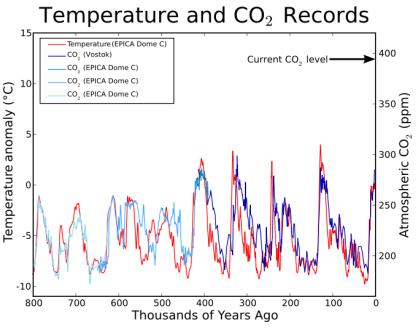By Jason Ho (Science Whiz) – Email
Date Posted: October 12, 2011
Print Edition: October 5, 2011
 Last column we discussed greenhouse gases, the history and origin of the idea of the greenhouse effect, and the known effectiveness of CO2 as an absorber of radiant energy. There is a definite relationship when comparing global temperatures over the past thousands of years to the concentrations of CO2 at those times. Temperature and atmospheric CO2 concentration data has been obtained largely through ice core samples taken all over the world (data is available through the US National Oceanic and Atmospheric Administration). Temperature data has also been collected from a variety of sources, such as tree ring growth, coral, and stalagmites. This data has provided reconstructions of historic temperature trends over the past 2000 years, also known from the media as the so-called “hockey stick” graph (Fig. 1).
Last column we discussed greenhouse gases, the history and origin of the idea of the greenhouse effect, and the known effectiveness of CO2 as an absorber of radiant energy. There is a definite relationship when comparing global temperatures over the past thousands of years to the concentrations of CO2 at those times. Temperature and atmospheric CO2 concentration data has been obtained largely through ice core samples taken all over the world (data is available through the US National Oceanic and Atmospheric Administration). Temperature data has also been collected from a variety of sources, such as tree ring growth, coral, and stalagmites. This data has provided reconstructions of historic temperature trends over the past 2000 years, also known from the media as the so-called “hockey stick” graph (Fig. 1).
The data clearly shows a sharp warming trend beginning around the 1900s that is anomalous when compared to previous warming and cooling cycles. Initially a topic of much controversy, the data describing these temperature trends has been compared against other independent data sources, and the same trends have been observed, confirming this trend in several cases. According to the combined historical temperature data, the Earth is the hottest it has been for at least the last 1300 years (Mann, 2008).
However, it is not simply the fact that temperatures are anomalously high that is drawing scientists’ attention – it is the rate at which this is occurring. The Earth goes through normal warming and cooling cycles dictated by factors such as solar activity and the precession of the Earth. What is alarming is that the magnitude of the changes scientists have observed over the past few decades are happening at an unprecedented rate; the changes in temperature being observed are comparable to historic changes which typically have happened over centuries.
Combining the temperature data with similarly obtained data on the concentration of CO2 in the atmosphere, there is a clear correlation between the two. In fact, in observing the concentration of CO2 in the atmosphere, one finds that levels were stable up until the late 19th century (based on data collected by the Carbon Dioxide Information Analysis Center), which is also around the time where global temperatures began to increase. By analyzing the ratios of different carbon isotopes in the atmosphere, scientists have determined that these rising levels are largely due to fossil fuel consumption (IPCC Fourth Assessment Report, 2007). It is not simply the correlation of the two data sets which leads scientists to believe that elevated levels of CO2 are the cause of the rising global temperatures. For example, NASA satellite data measuring the radiant energy escaping the earth has been recorded for the past 40 years, and the amount of energy escaping from the Earth in the wavelengths associated with those which CO2 absorbs shows a significant decrease.
Humanity has upset the balance in an otherwise neutral cycle; for thousands of years, the levels of CO2 in the atmosphere were regulated by volcanic activity, ocean absorption, and the rainforests. With the additional CO2 emitted by industrial activities and the destruction of the rainforests, these natural cycles simply cannot balance the excess. The science of climate change is rooted in basic, well-known physics and extensive measurements taken over the past century. Such principles have withstood the rigors of science, and as such, the validity of what is occurring around us at this very moment will not change. Temperatures are rising, and the world is in danger.


